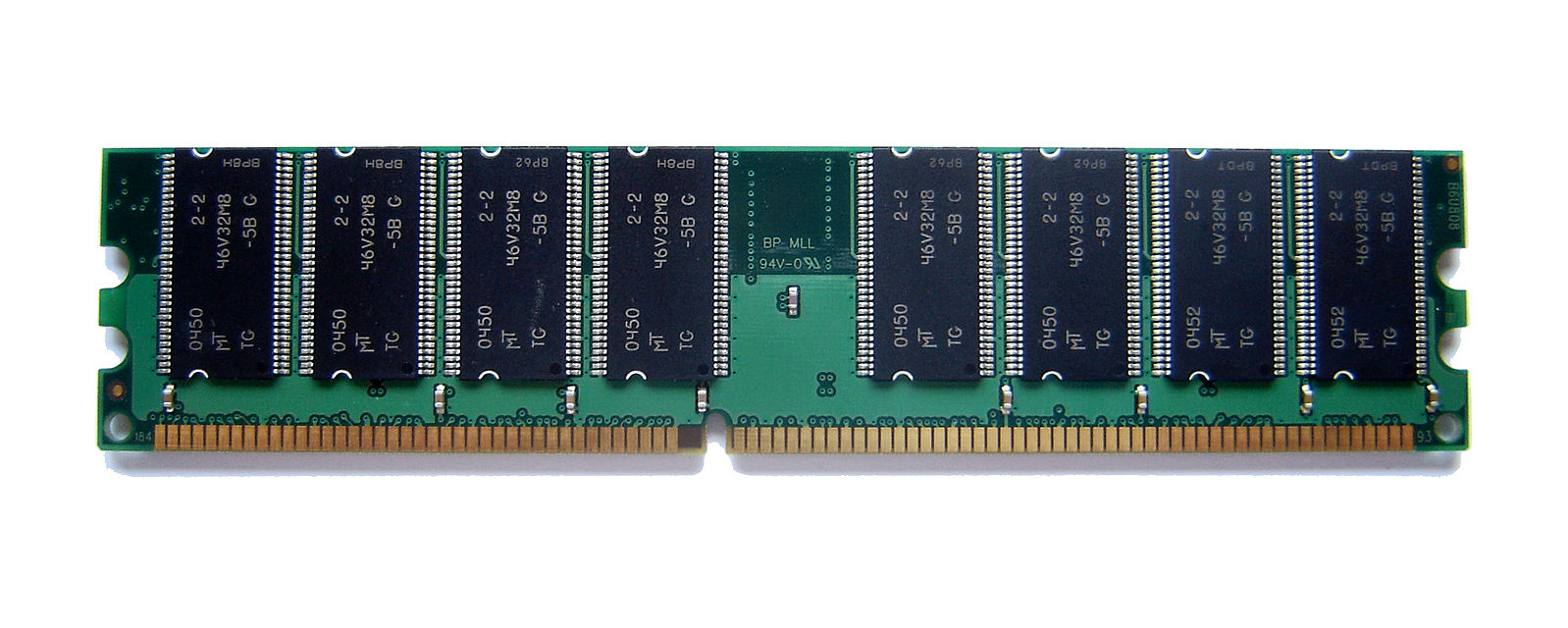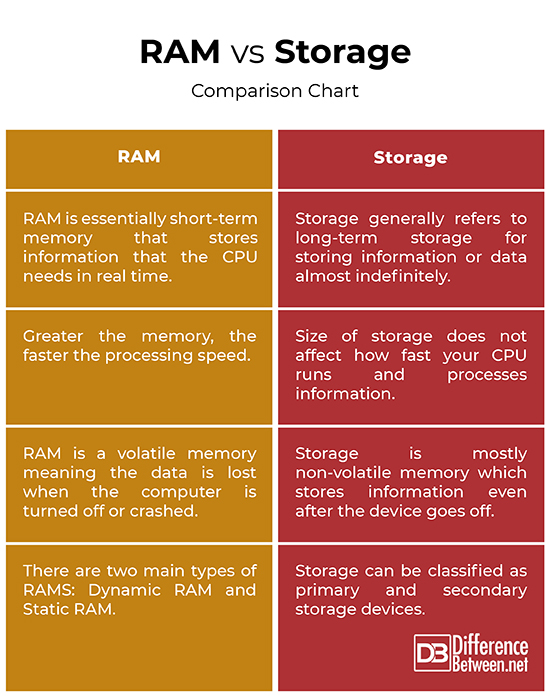Difference Between RAM and Storage
The Central Processing Unit (CPU) needs two types of memory to deal with data or instructions: Random Access Memory (RAM) and storage memory. RAM modules are volatile memory chips that hold the data and instructions need to be dealt with by the CPU. Before a CPU starts processing data, the RAM quickly loads the data and which can be quickly wiped away. People often interchange memory with storage, but there are significant differences between the two. Let’s take a look.

What is RAM?
RAM, short for Random Access Memory, is like a brain memory, a quick but volatile memory that stores information or data that is required by the CPU in real time and which clears when a computer loses its power or when it crashes. RAM holds the data that the CPU requires almost instantly like a program that is running or a game. The data loads into RAM before it is being processed by the CPU and can be quickly wiped away as the machine turns off or the program is closed. RAM works in conjunction with the hard drive which stores data for long-term. RAM is basically your system’s short-term memory storage device that stores the information or instructions that your computer is actively reading or writing so that it can be accessed by the CPU almost instantly.

What is Storage?
The term storage may refer to user’s data generally and more specifically, to an electronic memory device used to store digital data. Think of storage as book memory, the information or data that takes longer to access but is stored and accessed even after the computer is turned off. Storage memory devices use magnetic or optical media to hold information or data. Major types of storage memory devices include hard drives (HDDs), RAM, solid state drives (SSDs), optical disc drives, flash drives, and cloud storage. Storage devices are mostly non-volatile wherein data is stored and can stay indefinitely even when the computer isn’t in use or is turned off. Storage systems are classified based on the technologies used on how data is stored and accessed. Most of the computers use two types of storage: primary and secondary memory.
Difference between RAM and Storage
Memory
– RAM is a quick but volatile memory that stores information or data that is required by the CPU in real time and which clears when a computer loses its power or when it crashes. Operating system, programs such as web browser, MS Word, or a game are kept in the RAM so they can be quickly accessed by the CPU. Storage system is a hardware device connected to a computer through a network for storing the data. Storage memory devices use magnetic or optical media to hold information or data.
Role
– Storage is any type of computing hardware used to store all your applications, operating system, and digital content, such as photos, videos, music, and documents for an indefinite period. Storage devices can store data both temporarily and permanently based on the technology and hardware. RAM is a short-term memory storage device that holds the information that the CPU is actively using so it can process information immediately. RAM is where the currently running programs and the operating system are kept while the computer is running.
Performance
– RAM is almost exactly the same as the hard drive, except it is for temporary use. RAM plays an integral role in desktop computers and mobile devices for memory management. RAM affects the speed of the computer because every task a CPU processes is stored in the form of codes in the RAM, So, greater the memory, the faster the processing speed. The size of your storage device, however, does not affect how fast your processor runs or how quickly the computer processes a program or application. Size of the storage does not affect your computer’s performance.
RAM vs. Storage: Comparison Chart

Summary
Both RAM and storage are physical components of a computer that the CPU needs to deal with instructions or data. RAM is a type of volatile memory that holds the data and instruction set to be dealt with by the CPU. Before a CPU can do its job, the data gets quickly load into the RAM, and can be quickly wiped away after the computer is turned off or let’s say, crashed. So, RAM is kind of a short-term memory device that stores information temporarily. Storage systems, on the other hand, are for long-term storage and include hard drives, optical drives, solid state drives, flash drives, floppy drives, floppy disks, and SD cards.
Is it better to have high RAM or storage?
If your CPU is getting slow or your machine is running slow or lagging, then adding the RAM will help. The size of RAM determines how much of your machine’s data can fit into memory. Increasing the storage means you can store more digital content such as documents, videos, audios, pictures, etc.
Is RAM the same as storage capacity?
RAM is a temporary storage device which is measured in gigabytes (GB). The more GB of RAM your computer has, the more programs and applications it can run simultaneously. The speed of the RAM is measured in Megahertz (MHz).
What is difference between RAM and storage in mobile?
RAM is a medium for communicating data between CPU and internal storage. When a program is running, the data is copied from storage to RAM for quick access. The software instructions load into RAM. Storage in mobile usually refers to the capacity of your mobile device, which states how much data you can store.
Which phone has the highest RAM?
Asus ROG Phone 5 Ultimate has the highest RAM as of now, with a whopping 18 GB RAM and 512 GB ROM.
What is RAM or ROM in mobile?
A mobile phone memory consists of both RAM and ROM. RAM is the short-term memory that cannot hold the data without the power, and it functions just the same in mobile as it does in computers. More RAM means you can run multiple programs or applications at the same time. ROM is read only memory and refers to phone’s internal storage.
- Difference Between Caucus and Primary - June 18, 2024
- Difference Between PPO and POS - May 30, 2024
- Difference Between RFID and NFC - May 28, 2024
Search DifferenceBetween.net :
Leave a Response
References :
[0]Grant, August E. and Jennifer H. Meadows. Communication Technology Update and Fundamentals: 15th Edition. New York, United States: Routledge, 2016. Print
[1]Dutta, Susanta. Computer Storage Fundamentals. New Delhi, India: BPB Publications, 2019. Print
[2]Clarke, Glen E., et al. CompTIA A+ Certification All-in-One For Dummies. New Jersey, United States: John Wiley & Sons, 2019. Print
[3]Image credit: https://live.staticflickr.com/65535/49962249607_66a5fc685d_b.jpg
[4]Image credit: https://upload.wikimedia.org/wikipedia/commons/7/7c/RAM_module_SDRAM_1GiB.jpg
